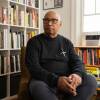Wander into the Institute of Contemporary Art’s Watershed outpost and you’ll be greeted with a brilliant sea of crimson rope hanging from the ceiling and what looks like an explosion in a paper factory. This is “Home Less Home” by Chiharu Shiota, one of over 20 public artworks on display for the Boston Public Art Triennial.
The first-of-its-kind show will present daring and contemporary public art throughout the city, from Almont Park in Mattapan to Roxbury Community College and Dock Square by Faneuil Hall.
This year’s pieces were opened to the public Thursday. “Home Less Home” is dazzling in scope, and it offers a magnetic invitation to sink into the piece itself. It’s emblematic of public art’s inclination to present itself before the people, and subject itself to unique, diverse interpretations.
Kate Gilbert founded the triennial project and addressed what she considers a misconception about contemporary art: that it is a tangential brush against artistic exclusivity. Art like “Home Less Home,” though, is what she calls a breadcrumb — an “in” to further exploration.
“Public art is this great democratizing of contemporary art,” she said. “It gives people access, for maybe the first time, to a piece of art that might be a little unknown. It makes people stop and think. It’s oftentimes by you, or is representing your community.”
Such is the case for “Home Less Home,” an installation that is spectacular in scale. Hundreds — if not thousands — of black and red ropes dangle from the ceiling. From the 110 miles of rope hang bits of paper — including passports and other immigration documents. But the most dominant feature in this interactive forest are the white papers that seem frozen in air as if being blown in the wind; or like a bird stopped mid-flight. And these fixtures are deeply personal.
“We invited people in Boston to contribute a response to what home means to them,” said Ruth Erickson, the ICA’s chief curator. “Somebody contributed a recipe for apple dumplings, somebody contributed an image of their golden retriever, somebody contributed an images of the child that they adopted from China and created a new home with. And as a visitor, you’re invited to walk through the piece and encounter these little vignettes that feel familiar ... but also otherworldly.”
An extra dimension is added by the presence of the black rope, which forms the negative outline of a house. Wandering from room to room not only allows you to pass through lives once (and currently) lived, but to reflect on the meaning of community. This is Chiharu Shiota’s first solo exhibition in the region, and the fact that it is in East Boston is particularly resonant, considering the neighborhood’s own immigrant history and morphing ethnic enclaves.
“East Boston is such an incredible community. [The] history of immigrants for so long have made this neighborhood what it is,” said Erickson. “To be be able come here, to be to walk the streets, visit the playgrounds, see these great artworks, it’s just such a chance to explore the city.”
It’s the project’s inaugural show: organizers are aiming to commission more art pieces in three years’ time under a new theme.
“Home Less Home” is one of more than 20 free public artworks being featured during the Triennial. The inaugural show runs through October 31.
Editor’s note: GBH is a media partner for the Boston Public Art Triennial.





